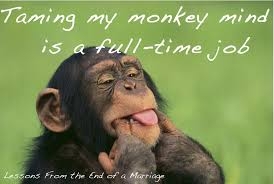How to be Mindful?
 lobster
Veteran
lobster
Veteran
Here iz plan:
Start with a bit of meditation. No can do?
OK onto the hard stuff ... which seems to be flavour of the secular month. Mindfulness.
I am preparing a Question and Answer routine for my blog, so let us begin. Mindful contributions welcome. 
Q: What is mindfulness?
A: Mindfulness is a mental state achieved by focusing one's awareness on the present moment, while calmly acknowledging and accepting feelings, thoughts, and bodily sensations.
bemindful.co.uk
Q: Is mindfulness more advanced than meditation?
A: It can, like meditation be used by beginners. In a sense, experienced meditators quite naturally extend their practice into daily life.
http://www.rd.com/health/wellness/10-steps-to-mindfulness/
Q: What are the benefits?
A: Improved health, improved mind, improved emotions
http://franticworld.com/what-can-mindfulness-do-for-you/
Q: Is meditation formal mindfulness?
A: Ideally yes.
Formal mindfulness, or meditation, is the practice of sustaining attention on body, breath or sensations, or whatever arises in each moment. Informal mindfulness is the application of mindful attention in everyday life.
https://en.m.wikipedia.org/wiki/Mindfulness



Comments
In the suttas it all begins with mindfulness of the body, which seems foundational.
as far as i remember, as per Therevada teachings of the Suttas, as taught by Thai Forest Tradition teachers, the Pali word sati, which is translated as mindfulness, does not refer to awareness as to be aware of what is going on, rather sati refers to keep something in mind in the sense of remembering. So anapanasati refers to mindfulness of breathing, meaning to keep breath (which is the meditation object) in mind and to be with breath. there is another Pali word sampajjana, which translates to clear comprehension of what is currently going on. so sati-sampajjana seems to together help in anapanasati meditation.
Sati is multi-layered and works with the other path factors. But we begin with paying attention to present experience, as per the Satipatthana Sutta.
Mindfullness is the attention of what one is doing. It is stabilising concentration in contrast to bewilderment.
therefore if one is walking one should pay attention to that and not doing 3 things together etc. that causes bewilderment.
Awareness is a state of non action, where things can appear spontaneous like sudden realisation etc.
knowing something can be done by first studying.
Then insight comes which is accumulated by Vipassana
Then Wisdom comes namely knowing without investigations etc.
Then it is self appearing after a while........
Last mentioned self appearing is not so well- known in all Buddhist Traditions that is right.
Therefore it does form a part of the highest teachings in Tibetan Buddhist Traditions.
Best wishes
KY
They pinched it all from the suttas anyway.
To me, mindfulness is magic. But then, it's something I re-learned -- something I long had forgotten about or how to do - which is strange because even though I haven't ridden a bicycle in ages, I don't think I'd have a problem with it. But this mindfulness stuff is something I think we were born with or so it seems. So, my question to myself is, how the bleep did I 'forget' how to do it?! Short answer seems to be all the frenetic activity and myriad distractions when we 'grow up' and become 'responsible citizens' or something. Other powers have taken advantage of that fact of life; it upsets the balance between powers - IYKWIM. It is interesting how life has unfolded - crazy - but interesting. Long live mindfulness!
My humble and limited understanding of mindfulness is the meeting of the present moment as it is. not trying to change change our thoughts /feelings just meeting every moment as it is.
being aware of the present moment andfacing turning towards the present monent regardless if it feels pleasant unpleasant or neutral. I've been told and I have read it is the only show in town which I'm finding to be very true I
You can harness it during meditation because I feel like mindfulness meditation is a training for the real game the real game is life itself off the cushion.
My personal entryways to mindfulness in every day life is following the breath and also going into my hands I find turning towards awareness of my hands to be useful when listening to somebody as it grounds me in the present moment. I can easily become aware of a tingling in the feet that I can also easily bring awareness towards. The more skilful practitioner will be able to bring mindfulness to their whole body easily much more easier than me. At the moment I'm just trying to use a few of the more obvious entryways to ground me in the now and I'm trying to build on to that by including my cheeks and butt cheeks! Personally during meditation I find the mindfulness of the breath to be the best way to remain present!
Mindfulness feels like coming home!
"How to be Mindful" .....Do nothing and Just be....and mindfulness will take care of the rest...and once present mindedness is mastered.... you will


But one must remember
From my experience, patience has been more helpful in gaining mindfulness than trying to obtain it. Its like trying to solve a puzzle. The more anxious and determined you are, the more irritated and frustrated you may get.
And what is the purpose of mindfulness? What's it for?
In a nutshell....It allows the minder to calmly & skilfully go with the flow of the day and not against it
, (which seems to be the usual mode of monkey mind)
Yes, mindfulness seems to have lots of benefits. I've found it's created the space for something deeper to emerge. A point of stillness perhaps?
Now that I have been making an effort to be more mindful. Find it incredible how I never knew how much negative emotion and general aversion I have throughout the day in my interactions with people. My favourite flavour is the feeling that moisture is getting sucked inwards from my eyes instead of outwards. This is due to a childhood of sucking the tears into my eye sockets. This happens most around my dad even now. However it does happen very regularly and I used to not be aware of it. Another favourite is pain in the chest an head when faced even with the slightest bit of stress!!
Good point.
That returning to physical sensations, for example the breath, illustrates the connection between formal stillness and mindfulness. Will think about a 'practice' Q: and A: for this ...
Yes indeed. Perhaps to be expressed like this:
Q: Is mindfulness 'meditation in activity'?
A: It is increasing stillness in active being. By attending to being and doing, rather than internal dialogue, fantasy, confused and conflicted being, we are attuning with a point of inner stillness.
Well some Dzogchen Traditions had a long time a single line lineage. This means that a Master had only one student and here the teachings were oral transmitted via a tube which was held at the ear of the student.
Later after many 100 years it was written down.
So memorisation was the fore runner of the Buddha Dhamma and Ananda is here a good example.
Then by personal experience the Dharma is reflected as true or not.
But sure learning from Sutras is a good preparation for self experience.
Best wishes
KY
Sure, but these teachings had their origins in Indian Buddhism, some say they were brought to Tibet by Padmasambhava. Dzoghen is a particular expression of Buddhist teachings, one among many.
These Dzogchen teachings can have different Lineages.
We have the Uddhiyana Dzogchen and Mahamudra Teachings.
Here is Garab Dorje / Prahe Vajra qua Dzogchen the Lineage
Padmasambhava taught the Dzogchen Khandro Nyingthig to numerous beings in India's eight great sacred places and China, and introduced and spread Buddhism throughout Tibet. His main disciple, the Dakini Yeshe Tsogyal, also taught the Dzogchen Khandro Nyingthig to many practitioners who achieved the enlightenment of Buddha. This tradition was handed down through the ages and later passed from Longchen Rabjam through to Dzogchen Padma Rigdzin. Today, the Dzogchen Khandro Nyingthig lineage lives in the heart of the Vajra master at Dzogchen monastery. Our master, the Great Natural Perfection Yogi Dzogchen Khenpo Choga Rinpoche, is the twenty-fourth holder of the Dzogchen Khandro Nyingthig lineage.
The oldest Dzogchen teachings stem from Buddha Tönpa Shenrab Miwoche and do belong to the Bön Dzogchen Tradition. Bön is about 18,000 years old and is the oldest spiritual tradition in Tibet. It stems from Tazik a province onece owned by the Persians.
Dzogchen is seen in the Tibetan Nyingma and Bön Traditions as the highest Teaching. It is here seen as the top teaching of the Lineage.
But in these Lineages is sure studied and practised Sutra and Tantra because Sutra, Tantra and Dzogchen do belong to the 84,000 Teachings / methods the Buddha gave to humans.
Best wishes
KY
Perhaps, but that has little significance outside Tibetan Buddhism.
Well it could be that these excellent mind teachings are not so well known in the world outside Tibetan Buddhism but that is changing slowly.
It is remarkable that Dzogchen adherents know Sutra,Tantra and Dzogchen, but is is seldom that Sutra and some Tantra adherents can get the picture regarding Dzogchen concepts.
This forms the reason that Dzogchen is a difficult to understand philosophy , because its meditations don´t deal with subject or object (conciousness). So an intellectual understanding that is very difficult regarding Dzogchen meditation.
Best wishes
KY
In my view Dzogchen concepts are unnecessarily over-complicated and often poorly communicated. I used to be involved in a Dzogchen school by the way, so I'm familiar with the tendency of practitioners to evangelise and make it sound like the best thing since sliced bread.
Hmm.
https://en.wikipedia.org/wiki/Bon
Well my background in Buddha Dharma goes back for some 30 years.
I did follow Theravada /Sutra ; Tantra and at the moment for 7 years Dzogchen.'
According my experience i can say that Dzogchen is easy to understand but hard to practice. It is less complicated that understanding and the practice of Tantra.
As a Dzogchenpa my way is:
A Dzogchenpa keeps them (Sutra, Tantra and Dzogchen) together, so in Dzogchen is finally everything (Buddha Dharma) present, but i agree that is not so well known outside the Dzogchen Traditions.
Best wishes
KY
A toast to something better than sliced bread ...
This is my Dharmakaya loaf. Slice this in memory of 'The Guru'.
1 Corinthians 11:24 (hi Tantra Edition)
... meanwhile ... after trying [mindfully] to access my blog and mindlessly failing, I managed to access this ello account I sent up when they started out ...
https://ello.co/crustylobster/post/eR4aZCkM0i-YzA_1WYj2_Q
I am very visually orientated, so their social media format will probably suit me much better than tumblr which seems to be disintegrating after yahoo acquisition. Also would be ideal for @Tosh and his amazing camera exploits.
You may recognise some of my older pics. Hope the Q: and A: are displaying ...